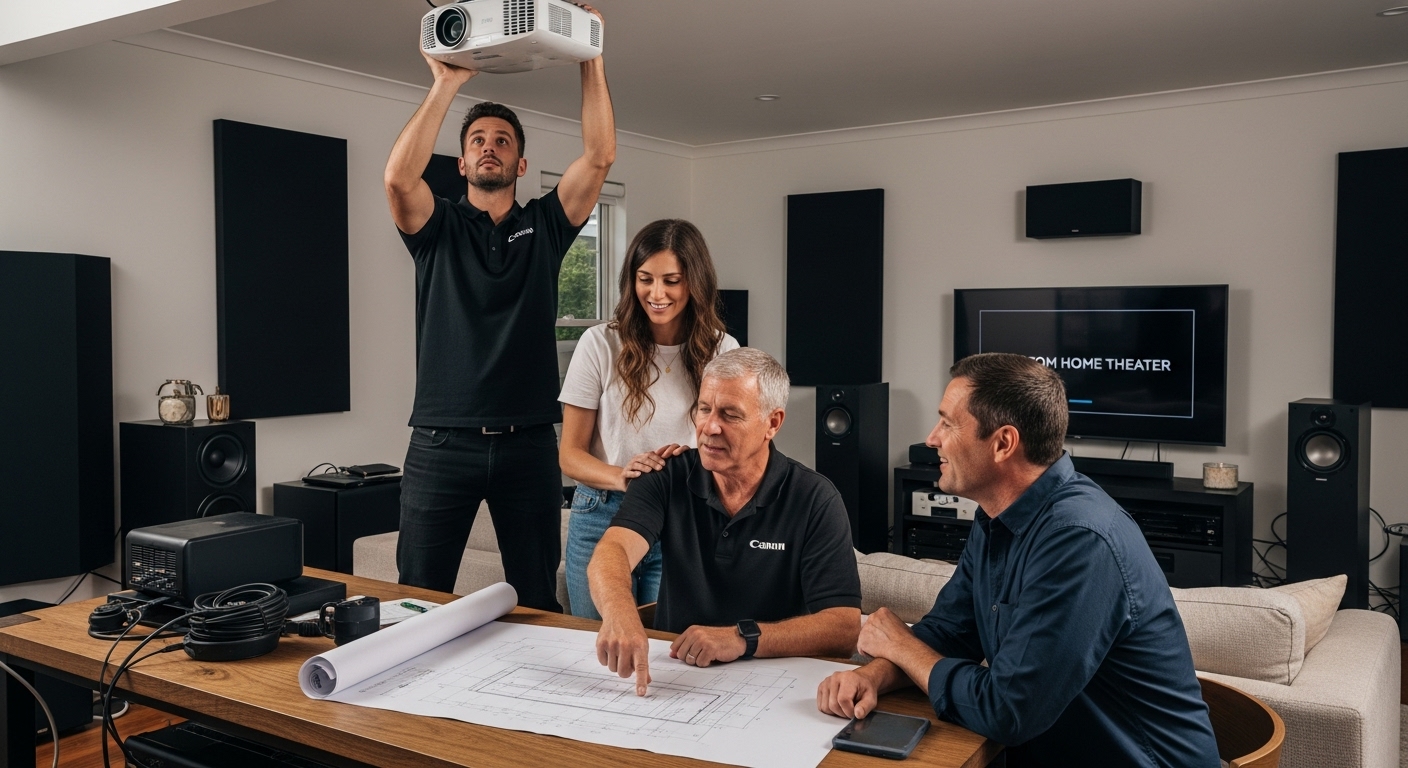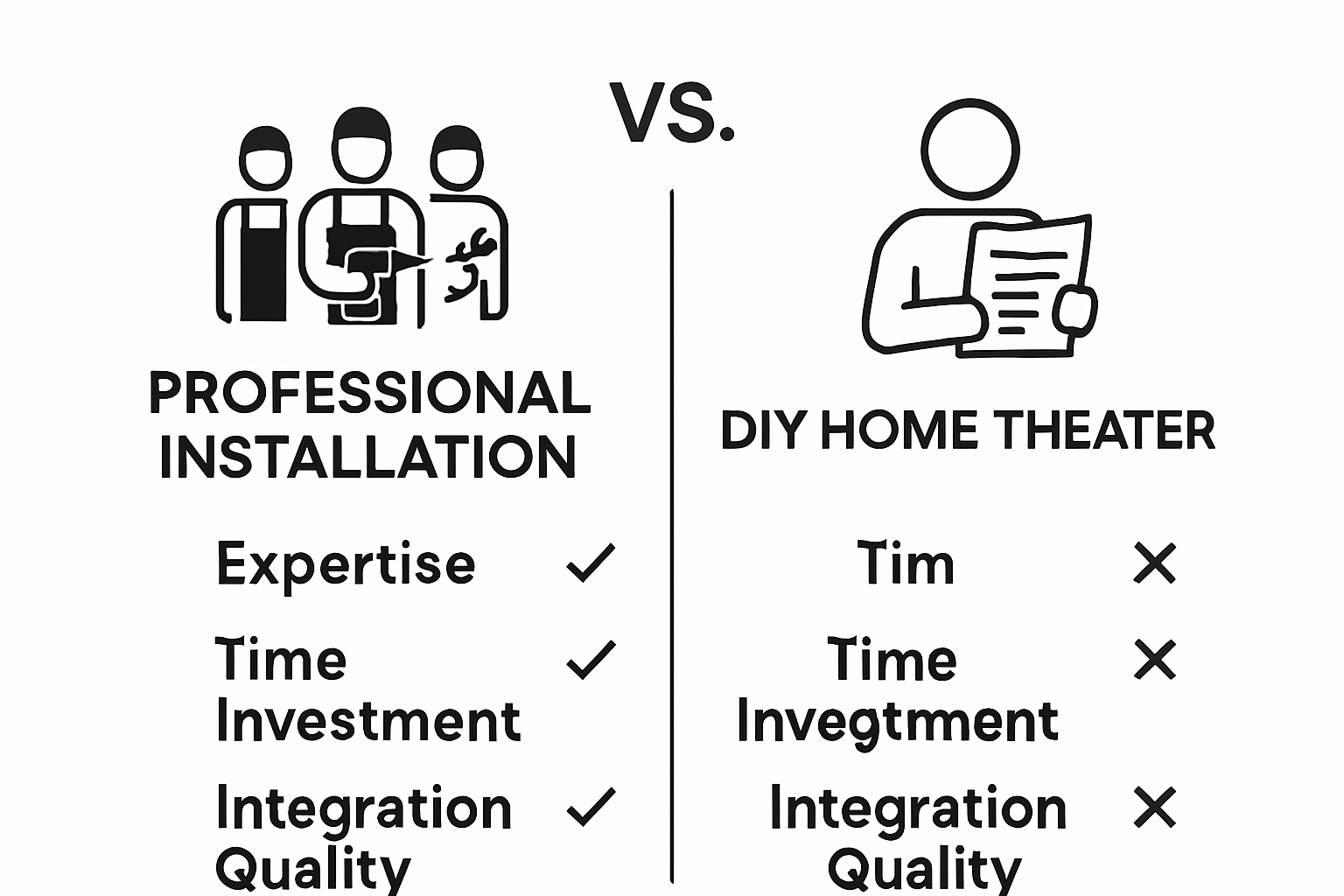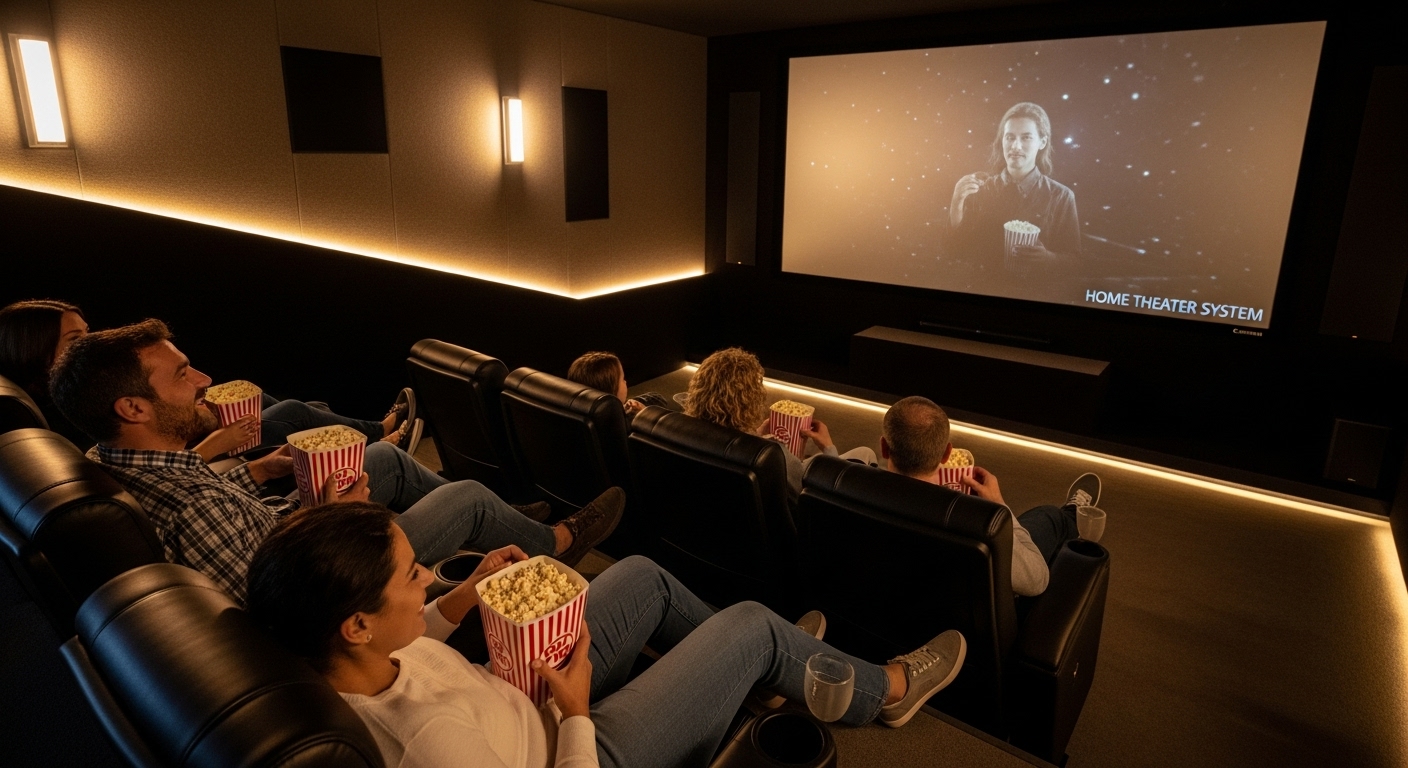Understanding Custom Home Theater Installation Guide
- garygarihanjr
- Sep 21
- 8 min read

Imagine turning your living room into a true cinematic escape. Some custom home theaters use acoustic engineering so precise that sound can travel seamlessly across a room without echo or distortion. Most people think it is all about splurging on enormous screens or top-tier speakers but that barely scratches the surface. The real magic is in how every bit of technology and design works together to deliver a theater experience you never thought possible at home.
Table of Contents
Quick Summary
Takeaway | Explanation |
Custom home theaters enhance entertainment experiences | They replicate professional cinema environments, integrating technology and design for immersive performances. |
Professional design ensures optimal performance | It involves precise engineering that enhances audio, visual quality, and overall entertainment sustainability. |
Holistic integration improves ease of use | By interconnecting systems, home theaters provide seamless control over audio, video, and lighting systems. |
Smart automation personalizes viewing experiences | Automation adjusts settings based on user preferences, creating responsive environments that cater to individual needs. |
Trends focus on experiential and adaptive design | Modern luxury home entertainment emphasizes integration, aesthetics, and environments that enhance user enjoyment. |
What is a Custom Home Theater?
A custom home theater transcends traditional entertainment setups by creating a specialized environment designed to replicate professional cinema experiences within residential spaces. Unlike standard television rooms or basic audio systems, these meticulously engineered spaces combine cutting-edge technology, precise acoustic design, and personalized architectural considerations to deliver an immersive audiovisual experience.
The Essence of Customization
Custom home theaters are not one-size-fits-all solutions. They represent a comprehensive approach to entertainment that considers multiple critical factors:
Room-specific acoustic engineering
Tailored audio and video equipment selection
Precise speaker and screen placement
Integrated lighting and control systems
Aesthetic design matching homeowner preferences
According to home theater engineering experts, these installations involve sophisticated technical processes that transform ordinary rooms into professional-grade entertainment zones. The goal is creating an environment where sound moves naturally, visuals appear crisp and immersive, and technological components seamlessly integrate.
Technology and Design Convergence
The magic of a custom home theater lies in its holistic approach. Professional installers evaluate room dimensions, surface materials, seating arrangements, and ambient light conditions to craft a scientifically optimized entertainment space. Read more about our approach to custom home theater design that transforms ordinary rooms into extraordinary cinematic experiences.
This isn’t merely about purchasing expensive equipment. It’s about creating a harmonious environment where technology and design converge to deliver unparalleled sensory experiences. From acoustically treated walls that eliminate sound distortions to precisely calibrated projection systems that render images with extraordinary clarity, every element is carefully considered and expertly implemented.
The Importance of Professional Home Theater Design
Professional home theater design represents a critical intersection between advanced technology, architectural expertise, and personalized entertainment experiences.
Unlike amateur setups, professional design ensures comprehensive performance, aesthetic integration, and long-term technological sustainability.
Technical Precision and Performance Optimization
Professional home theater design goes far beyond equipment selection. It involves sophisticated engineering principles that transform spaces into immersive entertainment environments. Key considerations include:
Acoustic wave management
Sound reflection and absorption calculations
Electromagnetic interference prevention
Thermal management for electronic components
Structural reinforcement for equipment stability
According to architectural acoustics research, professional design considers microscopic details that dramatically impact audio and visual performance. These nuanced interventions create environments where sound travels precisely, images appear flawlessly, and technological systems function harmoniously.
This table compares key benefits of professional home theater design with standard or amateur setups, highlighting why expert involvement yields superior results.
Feature/Benefit | Professional Design | Standard/Amateur Setup |
Acoustic Optimization | Yes, with precise engineering | Usually limited or generic |
Visual Performance | Tailored for space and light | Fixed, limited adjustments |
System Integration | Seamless smart and AV controls | Often separate or basic |
Aesthetic Customization | Matches homeowner preferences | Standard or off-the-shelf |
Long-Term Sustainability | Designed for future upgrades | Difficult to modernize |
Performance Consistency | Consistently high quality | Variable, prone to issues |

Comprehensive System Integration
A professionally designed home theater represents a complex ecosystem of interconnected technologies. Experts carefully map out comprehensive integration strategies that synchronize audio systems, visual displays, lighting controls, and smart home technologies. Check out our essential home theater design tips to understand the intricate planning required.
This holistic approach ensures that every technological component communicates seamlessly, preventing potential conflicts, minimizing signal degradation, and creating a unified, responsive entertainment environment. Professional designers understand that true luxury lies not just in expensive equipment, but in the invisible, intelligent infrastructure that makes extraordinary experiences possible.
Key Components of Home Theater Systems
A comprehensive home theater system integrates multiple sophisticated technological components that work seamlessly to create an immersive audiovisual experience. Understanding these critical elements helps homeowners make informed decisions about their entertainment infrastructure.
The following table summarizes the main components of a high-end home theater system along with their core functions to help readers quickly see how each part contributes to the experience.
Component | Purpose/Description |
Display Technology | Delivers visuals via screens or projectors with high resolution and clarity |
Audio System Architecture | Provides multi-speaker soundscapes for immersive audio |
Acoustic Treatments | Reduces echo and distortion to improve sound accuracy |
Lighting Control | Adjusts ambiance and manages glare for optimal viewing |
Smart Automation | Integrates and controls devices, lighting, and settings seamlessly |
Seating and Layout | Arranges viewing and listening positions for comfort and optimal effect |
Display and Visual Technologies
The visual centerpiece of any home theater system involves advanced display technologies. High-resolution screens and projection systems transform ordinary rooms into cinematic environments. Modern options range from ultra-high-definition televisions to precision-engineered projection systems that deliver extraordinary visual clarity.
Key display considerations include:
Screen size and aspect ratio
Resolution capabilities (4K, 8K)
Panel or projection technology
Contrast and color reproduction
Viewing angle performance
According to Energy Star guidelines, selecting the right display technology involves evaluating room dimensions, ambient lighting, and intended viewing experiences.
Audio System Architecture
Sound represents the emotional core of home theater experiences. Sophisticated audio systems translate visual narratives into immersive soundscapes. Explore our comprehensive guide to home theater sound systems to understand the intricate engineering behind exceptional audio performance.
A professional-grade audio system typically incorporates multiple speaker configurations, advanced receiver technologies, and precise acoustic calibration. These systems manage complex sound wave interactions, ensuring that every whisper and explosion emerges with stunning authenticity. The goal transcends merely playing sound - it involves recreating realistic, three-dimensional audio environments that complement visual storytelling.
How Smart Automation Enhances Home Theaters
Smart automation represents a revolutionary approach to transforming home theater experiences, seamlessly integrating advanced technological capabilities that elevate entertainment beyond traditional passive viewing. By connecting multiple systems through intelligent networks, homeowners can create responsive, personalized environments that adapt instantaneously to individual preferences.
Intelligent Control and Integration
Smart automation technologies enable comprehensive control of home theater environments through centralized interfaces. These sophisticated systems allow precise management of multiple technological components, creating harmonious interactions between audio, visual, lighting, and environmental controls.
Key automation capabilities include:
Voice-activated system controls
Automated lighting synchronization
Temperature and ambiance adjustments
Personalized scene programming
Remote access and monitoring
Professional smart home integrators understand that true automation transcends simple remote control. It involves creating intelligent ecosystems where technological components communicate seamlessly, anticipating user needs and delivering extraordinary experiences.
Personalization and Adaptive Technologies
Smart home automation introduces unprecedented levels of personalization to home theater environments. Learn more about transforming your living space with smart home technologies to understand the depth of customization possible.
Modern systems can recognize individual user preferences, automatically adjusting sound levels, screen brightness, seating positions, and ambient lighting based on previous viewing patterns. This level of adaptive technology transforms home theaters from static entertainment spaces into dynamic, responsive environments that understand and anticipate viewer requirements, creating truly immersive and personalized experiences.
Trends in Luxury Home Entertainment
Luxury home entertainment has undergone a transformative evolution, moving far beyond traditional viewing experiences into immersive, technologically sophisticated environments that reflect personal style and cutting-edge innovation. Modern homeowners seek integrated systems that blend seamless functionality with aesthetic elegance.
Technological Integration and Immersion
Cutting-edge entertainment systems now represent more than mere audiovisual equipment. They embody comprehensive lifestyle experiences that transform residential spaces into personalized media sanctuaries. Contemporary trends emphasize holistic technological integration that transcends conventional entertainment boundaries.
Key emerging trends include:
Artificial intelligence driven personalization
Seamless multi-room entertainment connectivity
Ultra high definition projection technologies
Integrated wellness and entertainment experiences
Adaptive environmental control systems
According to luxury housing technology research, homeowners increasingly demand systems that anticipate and respond to individual preferences with unprecedented precision.
Experiential Design Philosophy
Luxury home entertainment now prioritizes experiential design that goes beyond technological specifications. Explore why investing in advanced home theaters enhances luxury living, understanding that these spaces are about creating memorable moments.
Today’s entertainment environments are conceived as dynamic, adaptive spaces that blur traditional boundaries between technology, design, and personal experience. They represent sophisticated ecosystems where audiovisual technologies, architectural design, and individual lifestyle preferences converge to create uniquely personalized entertainment sanctuaries.

Ready for a Truly Personalized Home Theater Experience?
Are you struggling with the overwhelming options and technical details of custom home theater installation? If you want immersive sound, flawless visuals, and seamless control—as described in our article—but feel uncertain about system integration or design expertise, you are not alone. Many homeowners seek that cinema-quality experience but hesitate due to the risks of subpar installations and the complexity of combining acoustics, smart automation, and aesthetic goals.
Imagine enjoying tailored solutions designed around your space and lifestyle. Our team at Techology Experts specializes in high-end custom home theater installations and smart automation for discerning clients. We take care of every critical element—from acoustic engineering and display selection to unified smart controls—so you can relax and enjoy the magic of a professionally crafted entertainment space. Discover our tailored approach to custom home theater design or see what’s possible by exploring why investing in advanced home theaters enhances your lifestyle.

Your dream home theater is within reach, but the first step is to talk with specialists who understand your goals. Visit https://techologyexperts.com now to request a private consultation. Let us transform your vision into an extraordinary, seamless experience before your next movie night arrives.
Frequently Asked Questions
What is a custom home theater?
A custom home theater is a specialized environment designed to replicate professional cinema experiences within residential spaces, incorporating advanced technology, acoustic design, and personalized aesthetics.
How important is professional design in home theater installation?
Professional design ensures optimal performance and aesthetics, utilizing sophisticated engineering principles to create immersive audio-visual environments that standard setups cannot match.
What are the key components of a home theater system?
Key components include display technologies (like high-resolution screens), audio systems (with advanced speaker configurations), and integration of smart automation for a seamless entertainment experience.
How can smart automation enhance my home theater experience?
Smart automation allows for centralized control of multiple systems, enabling personalized settings such as lighting, sound, and environmental controls. This creates adaptive environments that respond to individual preferences for a more immersive experience.
Recommended
Comments